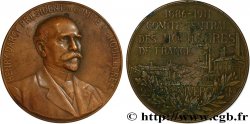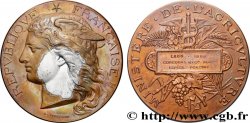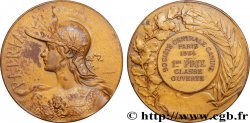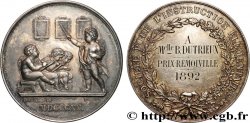fme_806543 - III REPUBLIC Médaille, Sadi Carnot, Inauguration de l’exposition du centenaire de 1789
140.00 €
Количество
Добавить в корзину

Тип Médaille, Sadi Carnot, Inauguration de l’exposition du centenaire de 1789
Дата: 1889
Металл: bronze
Диаметр: 67,5 mm
Ориентация осей монеты: 12 h.
Гравер DUBOIS Alphée (1831-1905)
Вес: 162,26 g.
Век: lisse + corne BRONZE
Пуансон: corne BRONZE
Комментарии о состоянии
Patine hétérogène, traces d’un ancien nettoyage. La médaille est conservée dans un écrin rouge à liseré doré
Лицевая сторона
Аверс: легенда: CARNOT PRÉSIDENT DE LA RÉPUBLIQVE FRANÇAISE.
Аверс: описание: Buste habillé de Sadi Carnot à gauche, signé : ALPHEE DUBOIS.
Обратная сторона
Реверс: легенда: LE 6 MAI 1889 / M. CARNOT / PRESIDENT DE LA REPUBLIQUE / INAUGURE / L’EXPOSITION DU CENTENAIRE DE / 1789 / - / MINISTRES SECRETAIRES D’ETAT / M. M. TIRARD PRESIDENT DU CONSEIL / MINISTRE DU COMMERCE DE L’INDUSTRIE ET DES COLONIES / COMMISSAIRE GENERAL DE L’EXPOSITION UNIVERSELLE / THEVENET, JUSTICE ET CULTES / SPULLER, AFFAIRE ETR.ES / CONSTANS, INTERIEUR / ROUVIER, FINANCES / DE FREYCINET, GUERRE // KRANTZ, MARINE / FALLIERES, INS.ON P.E ET B.ARTS / YVES GUYOT TRAVAUX PCS / FAYE AGRICULTURE // M. LE ROYER, PRESIDENT DU SENAT / M. MELINE, PRESIDENT / DE LA CHAMBRE / DES DEPUTES.
Реверс: Описание: Légende en 20 lignes.
Комментарий
Sadi Carnot, né le 11 août 1837 à Limoges et mort le 25 juin 1894 à Lyon (3e arrondissement), de son nom complet Marie François Sadi Carnot, est un homme d'État français. Il fut président de la République du 3 décembre 1887 jusqu'à ce qu'il meure assassiné le 25 juin 1894.
Haut fonctionnaire de carrière, Sadi Carnot, avant de se faire élire à l'Élysée, avait assumé de nombreuses charges politiques et gouvernementales : député de la Côte-d'Or, préfet de la Seine-Inférieure, puis sous-secrétaire d'État aux Travaux, il fut nommé ministre des Travaux publics, puis des Finances.
Dans un contexte d'agitation syndicale et anarchiste, les lois restreignant les libertés individuelles et la presse venaient d'être votées, Sadi Carnot est l'une des cibles du mouvement anarchiste ayant refusé la grâce de Ravachol, d'Auguste Vaillant, auteur de l'attentat à la Chambre des députés et d'Émile Henry. Il est blessé d'un coup de poignard par l'anarchiste italien Sante Geronimo Caserio le 24 juin 1894, alors qu'il quittait, par une issue secondaire pour éviter la foule, un banquet organisé à la Chambre de commerce à l'occasion de l'exposition universelle, internationale et coloniale à Lyon. Le député Gaston Doumergue, futur président de la République, est témoin de la scène. Caserio est guillotiné le 16 août suivant pour le crime.
Le président de la République meurt des suites de ses blessures, peu après minuit, le 25 juin 1894.
Son assassinat fait adopter par la Chambre la dernière et la plus marquante des lois scélérates visant les anarchistes et leur interdisant tout type de communication. Elle a été abrogée en 1992.
Il repose au Panthéon de Paris avec son grand-père Lazare Carnot.
Sadi Carnot, born August 11, 1837 in Limoges and died June 25, 1894 in Lyon (3rd arrondissement), whose full name was Marie François Sadi Carnot, was a French statesman.. He was President of the Republic from December 3, 1887 until his assassination on June 25, 1894..
A senior career civil servant, Sadi Carnot, before being elected to the Élysée, had held numerous political and governmental positions: deputy for Côte-d'Or, prefect of Seine-Inférieure, then under-secretary of state for works, he was appointed minister of public works, then of finance.
In a context of union and anarchist unrest, laws restricting individual freedoms and the press had just been passed, Sadi Carnot was one of the targets of the anarchist movement that refused to pardon Ravachol, Auguste Vaillant, author of the attack on the Chamber of Deputies, and Émile Henry.. He was stabbed by the Italian anarchist Sante Geronimo Caserio on June 24, 1894, as he was leaving, through a secondary exit to avoid the crowd, a banquet organized at the Chamber of Commerce on the occasion of the Universal, International and Colonial Exhibition in Lyon.. Deputy Gaston Doumergue, future President of the Republic, witnessed the scene. Caserio was guillotined on August 16 for the crime..
The President of the Republic died of his injuries shortly after midnight on June 25, 1894..
His assassination led to the adoption by the House of Commons of the last and most significant of the villainous laws targeting anarchists and prohibiting them from any type of communication.. It was repealed in 1992.
He rests in the Pantheon in Paris with his grandfather Lazare Carnot
Haut fonctionnaire de carrière, Sadi Carnot, avant de se faire élire à l'Élysée, avait assumé de nombreuses charges politiques et gouvernementales : député de la Côte-d'Or, préfet de la Seine-Inférieure, puis sous-secrétaire d'État aux Travaux, il fut nommé ministre des Travaux publics, puis des Finances.
Dans un contexte d'agitation syndicale et anarchiste, les lois restreignant les libertés individuelles et la presse venaient d'être votées, Sadi Carnot est l'une des cibles du mouvement anarchiste ayant refusé la grâce de Ravachol, d'Auguste Vaillant, auteur de l'attentat à la Chambre des députés et d'Émile Henry. Il est blessé d'un coup de poignard par l'anarchiste italien Sante Geronimo Caserio le 24 juin 1894, alors qu'il quittait, par une issue secondaire pour éviter la foule, un banquet organisé à la Chambre de commerce à l'occasion de l'exposition universelle, internationale et coloniale à Lyon. Le député Gaston Doumergue, futur président de la République, est témoin de la scène. Caserio est guillotiné le 16 août suivant pour le crime.
Le président de la République meurt des suites de ses blessures, peu après minuit, le 25 juin 1894.
Son assassinat fait adopter par la Chambre la dernière et la plus marquante des lois scélérates visant les anarchistes et leur interdisant tout type de communication. Elle a été abrogée en 1992.
Il repose au Panthéon de Paris avec son grand-père Lazare Carnot.
Sadi Carnot, born August 11, 1837 in Limoges and died June 25, 1894 in Lyon (3rd arrondissement), whose full name was Marie François Sadi Carnot, was a French statesman.. He was President of the Republic from December 3, 1887 until his assassination on June 25, 1894..
A senior career civil servant, Sadi Carnot, before being elected to the Élysée, had held numerous political and governmental positions: deputy for Côte-d'Or, prefect of Seine-Inférieure, then under-secretary of state for works, he was appointed minister of public works, then of finance.
In a context of union and anarchist unrest, laws restricting individual freedoms and the press had just been passed, Sadi Carnot was one of the targets of the anarchist movement that refused to pardon Ravachol, Auguste Vaillant, author of the attack on the Chamber of Deputies, and Émile Henry.. He was stabbed by the Italian anarchist Sante Geronimo Caserio on June 24, 1894, as he was leaving, through a secondary exit to avoid the crowd, a banquet organized at the Chamber of Commerce on the occasion of the Universal, International and Colonial Exhibition in Lyon.. Deputy Gaston Doumergue, future President of the Republic, witnessed the scene. Caserio was guillotined on August 16 for the crime..
The President of the Republic died of his injuries shortly after midnight on June 25, 1894..
His assassination led to the adoption by the House of Commons of the last and most significant of the villainous laws targeting anarchists and prohibiting them from any type of communication.. It was repealed in 1992.
He rests in the Pantheon in Paris with his grandfather Lazare Carnot








 Cообщить об ошибке
Cообщить об ошибке Распечатать страницу
Распечатать страницу Отправить мой выбор
Отправить мой выбор Задать вопрос
Задать вопрос Consign / sell
Consign / sell
 Информация
Информация









